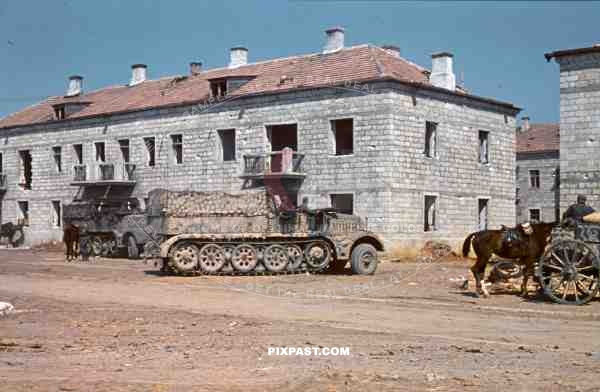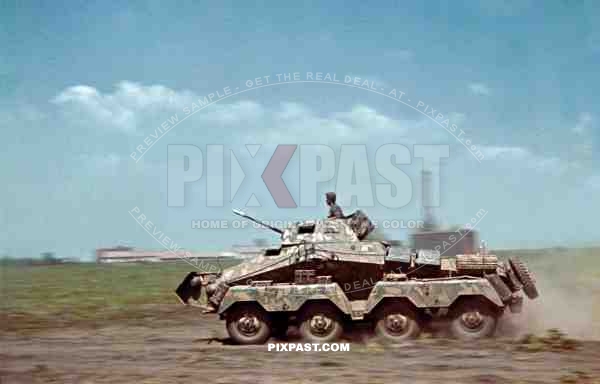When the original units were slated to head to Afrika, were there vehicles painted in grey or did they receive a fresh paint or Dunkegelb before railheading to the ports and then onward to Africa?
I don’t think they were painted Dunkelgelb.I believe they were painted in the Tropen Scheme RAL 8000 and RAL 7008,might be over gray.
Someone will know for sure.
Here’s a one page summary -
https://panzerworld.com/german-armor-camouflage
While one should never assume anything to be 100%, by the time the order for the ‘dunkelgelb’/3 color was even issued, let alone implemented, the campaign in North Africa was moving to its conclusion.
Only in the final phase of the Africa campaign, in Tunisia spring 1943, was there any Dunkelgelb equipment for Panzer Armee Afrika.
So safe assumption was everything was grey then the elements naturally weathered it
No. The earliest stuff was gray, then camouflaged in theater. First with mud, then later with the Tropen paints as they became available for surviving equipment. Reinforcements and replacement items were mostly painted in Tropen colors prior to shipment to Africa.
Hasty repaints for 10th Panzer and other response units sent after the Torch landings happened in late 1942, with the 1942 Tropen colors.
Yes, the original units on their way to Africa would be in grey. Later equipment was painted in theater. It is possible subsequent vehicles came in colors already painted prior to shipping.
I am going to refer you to chipset accurate paint set here
https://acrylicosvallejo.com/en/producto/hobby/sets/afv/dak-colors-1941-1944-71207-es/
Also you will find that in the latter stages of the war some of the Afrika Korps colours were used in facturies when Dunkelgelb stocks ran out.
The first unit sent to Africa was the 5. Leichte-Division (later in August 1941 it was renamed 21. Panzer Div.) and these were the only combat vehicles sent in grey paint. There are many photos of their landing and parade at Tripoli.
There is some opinion that only recon vehicles (and perhaps the earliest in arrivel of some motorized AT) were camouflaged with local sand/mud mixes, as these vehicles were sent immediately forward to scope out British dispositions. The main armoured units remained in Sirte for a work up period before the first offensive was launched on the 24th of March. Tropical colours were decided upon a week prior on the 17th - whether that was enough time to send paint tins of RAL 8000 as well as apply a hurried paint job is unknown. Sirte does have an airfield, so who knows. Some have suggested possible Italian paints were used, but they too did not officially have a desert sand paint for their army until a decision was made on the 18th, a day after a choice was made for the Afrikakorps.
The next tank unit, the 15. Panzer Div., arrived between April 24 and May 6th 1941. These were finished in tropical paint at the factory. What is further interesting about these vehicles, they arrived with the rubber sides of road wheels and return rollers painted in white. Apparently this was just for parade purposes while at their Italian harbour before boarding ships.

regards,
Jack
That’s very interesting about the white wheels. I’ve been trying to plan a diorama where German equipment is on railcars, with one line sending equipment east for the build up to Barbarossa while another train is heading to Italy to embark elements on the Afrika korp onto ships and send them to Tripoli. I thought it’d look cool to have the trains stopped in a rail Yard with some soldiers in there field grey uniforms looking at the Afrika korp Possibly collecting their tropical gear or just hanging out waiting for the rail transport to begin moving again. Im Still deciding on this part. But i feel like that would have been a common site seeing a train going west with equipment in tropical colors while another is heading east.
They wore tropen colors in Russia also during the summer,didnt they ? I think they wore gray for Barbarossa,but summer of 42 on was it still gray ?
Gray was the factory base color for German vehicles from the start of Barbarossa until February 1943. But units and equipment slated for North Africa were diverted to Russia to replace losses. Sometimes in the Tropen colors. And those colors worked fairly well on the open steppes of Russia & Ukraine.
Well you could do something like that where the Tiger battalions were formed. 501st was slated for North Africa while 502nd was slated for Russia. Both were formed and equipped around the same time in drips and drabs as the equipment was shipped to the base from the factory. Lead elements of 502 went to Russia first. But in late summer, early fall of 1942, both units were still learning how to use their new equipment and ironing out all of the kinks in organization and doctrine.
Thatd be a cool looking diorama. Have a tiger going one way followed with a railcar with a support vehicle then another tiger going another way painted in tropical colors with another support vehicle.
At the moment, it’s uncertain if desert paints were issued directly to troops in Russia in 1942, but as Chory describes in his book on Wehrmacht Camouflage Colors, by summer of that year the German army was realizing that the standard grey scheme was no longer suitable.
There are couple photo examples that do seem to indicate troops were applying some kind of sand coloured paint to their vehicles in the Crimea (considered a tropical zone):


https://www.tapatalk.com/groups/missinglynx/untitled-t57829-s10.html
David Byrden has recently put together an article on his site discussing the possibility of there only being 25 tigers leaving the factory in grey. Up to the individual to make their conclusion:
http://tiger1.info/EN/Grey-Tigers.html
regards,
Jack
Here is one that might not be colorized since it is from Getty images:
Could this one be a gray Tiger in North Africa?
http://ww2live.com/sites/default/files/images/20150604175737.jpg
Only problem with black and white photos is that it’s hard to tell if it’s a gray or a desert/ dark yellow!
Some more info on that particular Tiger b/w photo here:
http://tiger1.info/tank-page/A2B
Operations in Tunisia were considered a last ditch effort by the Axis, and for that reason, some tend to think sending Tigers to the area was a last minute decision and therefore, arrived in Africa in their European grey scheme. On the contrary, Hilter had promised Rommel two Tiger battalions for use in Egypt with plans to have them there by October:
Production delays, the defeat at El Alamein and the Torch Landings on Nov.7, precipitated a change in plans. The Tigers still should have been in tropical colours straight from the factory.
regards,
Jack